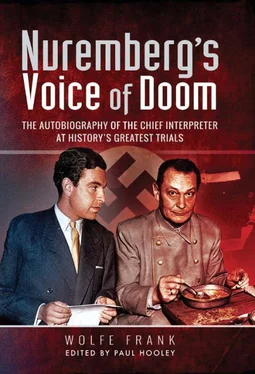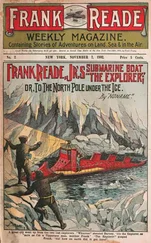A Cockney was at one-time defined as a person born within the sound of the bells of St Mary-le-Bow church in Cheapside, City of London.
Nacht und Nebel (Night and Fog) was a decree, issued by Hitler in 1941, which dealt with the elimination of persons in occupied territories. Victims of the decree were said to have disappeared into the night and fog without a trace.
A mimeograph was a duplicating machine that forced ink through a stencil.
Public urinal.
Lord Justice Robert H. Jackson was the US Chief of Counsel at the IMT.
Gertrude Scholtz-Klink. later known as Maria Stuckebrock, was a Nazi Party member and leader of the National Socialist Women’s League.
Dwight David ‘Ike’ Eisenhower (1890–1969) was the 34th President of the USA (from 1953 until 1961). During The Second World War he was a five-star general and Supreme Commander of the Allied Expeditionary Forces in Europe.
In June 1934 Adolf Hitler stated to a British journalist: ‘At the risk of appearing to talk nonsense I tell you that the National Socialist movement will go on for 1,000 years! Don’t forget how people laughed at me 15 years ago when I declared that one day I would govern Germany.’ At the Nazi Party Congress in Nuremberg in September of the same year the Fuehrer also declared: ‘It is our will this state will endure for a thousand years!’ In fact it endured for just twelve years. However Hans Frank, one of the defendants tried, found guilty and executed at Nuremberg, declared at the IMT: ‘A thousand years will pass and still this guilt of Germany will not have been erased’.
Heinrich Luitpold Himmler (1900-1945) was Reichsfuehrer (Commander) of the SS and a leading member of the Nazi Party. Hitler appointed him a military commander and later Commander and administrator of the entire Third Reich. Himmler was one of the most powerful men in Nazi Germany and one of the people most directly responsible for the Holocaust. He was arrested by the British at the end of the war and committed suicide in May 1945.
Marinus van der Lubbe (1909-1934), a Dutchman, was tried, convicted and executed for setting fire to the Reichstag building in Berlin on 27 February 1933, an event that became known as the Reichstag fire.
On 20 July 1944, Claus von Stauffenberg and others attempted to assassinate Adolf Hitler in his field headquarters near Rastenburg, East Prussia.
After the war the Allied Powers initiated a comprehensive ‘de-Nazification’ programme. Its purpose was to eradicate National Socialist thought from political, economic, intellectual and cultural life. Nazi laws were abolished and all signs and symbols of National Socialism were removed. The main focus of the programme was the systematic screening of all former members of the NSDAP – party membership was defined as the criteria for their dismissal from executive positions in industry and from public office.
Paul Joseph Goebbels (1897-1945) was Germany’s Minister of Propaganda from 1933 to 1945 and one of Hitler’s closest associates and most devoted followers. He advocated progressively harsher discrimination against the Jews, including extermination in the Holocaust. On 30 April 1945, Goebbels succeeded Hitler as Chancellor, the following day he and his wife committed suicide, after poisoning their six children with cyanide.
Rudolf Diels presented an affidavit for the prosecution at the Nuremberg Trials and was also summoned to testify in Goering’s defence. After 1950 he served in the post-war government of Lower Saxony and then in the Ministry of the Interior. He died on 18 November 1957 when his rifle accidentally discharged while he was hunting.
Following the Nuremberg Trials Wolfe Frank risked his life again by going underground in both West and East Germany to write a series of articles for the New York Herald Tribune (NYHT). During this period Diels was instrumental in bringing to Frank’s attention the whereabouts of one of the highest ranked Nazi officers on the Allies most wanted list. Single-handedly Frank tracked him down, confronted him and turned him over to the authorities, not before however he had personally taken the Nazi’s confession. The fascinating story of Frank’s undercover operations for the NYHT are the subject of a separate volume entitled The Undercover Nazi Hunter: Unmasking Evil in Post-war Germany soon to be published by Frontline Books.
Many German-owned properties and estates were seized by the Property Control Division and handed over to reliable Germans or were held by the Board until the Control Council decided how to dispose of them in the interests of peace.
The Allgau is a region in southern Germany that covers parts of the south of Bavaria and parts of Austria and stretches from the pre-alpine lands up to the Alps.
Sir David Maxwell Fyfe (1900-1967) was a Member of Parliament, lawyer and judge who variously held the offices of Solicitor General, Attorney General, Home Secretary and Lord High Chancellor. He later became the Earl of Kilmuir. At Nuremberg he was Britain’s Deputy Chief Prosecutor and his cross-examination of Hermann Goering, which was translated by Wolfe Frank, is regarded as having been one of the most noted in history. At the time he was preparing to go underground in Soviet-occupied East Germany to write his ‘ Hangover After Hitler ’ series for the NYHT . Sir David wrote, ‘From my knowledge and daily experience of your performance as a most efficient and capable interpreter during the trial of the major Nazi War Criminals at Nuremberg, I know that you have a profound knowledge of the Nazi Background in Germany, both from the historical and the personal point of view.’
Airey Middleton Neave (1916-1979) was the first British officer to successfully escape from the prisoner-of-war camp at Colditz Castle and later worked for MI9. A well-qualified lawyer, he spoke fluent German and at the IMT in Nuremberg he read the indictments to the Nazi war criminals on trial and was an investigator for the Krupp trial. He was elected MP for Abingdon in 1953 and was assassinated in March 1979 when an IRA bomb was exploded under his car as he drove out of the Palace of Westminster car park.
Colonel Leon Dostert (1904-1971) was a French born American scholar of languages who introduced Simultaneous Interpretation to the world at the Nuremberg Trials where he was Head of the US Language Division.
The Bürgerbräukeller was a large beer hall in Munich where, on 8 November 1933, an assassination attempt was made on Hitler’s life.
Carinhall, in the Schorfheide Forest north-east of Berlin, was Hermann Goering’s country residence.
Goering was injured in the Beer Hall Putsch in 1923 and whilst receiving treatment for his injuries he developed an addiction to morphine, which persisted until the end of his life. Whilst awaiting trial at Nuremberg he was weaned off the drug and put on a strict diet, losing some 27k in weight, it has been said.
Maximilian Schmeling (1905-2005) was a German former world heavy-weight boxing champion who fought American Joe Louis in New York in 1938 for the world title. Because of their national associations the fight became a worldwide cultural event. Louis won by knocking Schmeling out in the first round – an event that did not please Adolf Hitler or the Nazi Party.
Читать дальше












